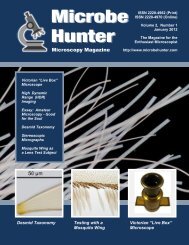October 2012 - MicrobeHunter.com
October 2012 - MicrobeHunter.com
October 2012 - MicrobeHunter.com
Create successful ePaper yourself
Turn your PDF publications into a flip-book with our unique Google optimized e-Paper software.
Comparing objectives<br />
TESTING<br />
4-6). This effect is more disturbing<br />
when taking pictures, but not a big<br />
problem when only working visually.<br />
By operating the fine focus knob, one<br />
could also bring these areas into focus.<br />
Figure 6 shows a picture through the<br />
eyepiece of the educational microscope<br />
itself. There is much less blurriness.<br />
Probably the smaller field of view that<br />
the eyepiece produced eliminated the<br />
critical areas at the side.<br />
I also used the attached camera to<br />
take pictures through the trinocular<br />
head. This camera did not capture the<br />
full field, but rather a rectangular section<br />
from the center of the field of view.<br />
Therefore the blurry sides were eliminated<br />
from the picture. Some loss of<br />
quality is still visible in the <strong>com</strong>parison<br />
pictures, however (figures 2-3 and 6-9).<br />
The 4x objective resulted in the worst<br />
image quality at the sides, probably also<br />
because of its wide field of view.<br />
The short verdict<br />
If you are looking for a low-cost<br />
microscope, either for yourself or as a<br />
present for your children, then I would<br />
say that microscope that I tested can be<br />
seen as a good reference on what to<br />
expect from a EUR 200-250 microscope.<br />
The microscope is definitely not<br />
a toy and sufficiently solid to be taken<br />
seriously. The image quality of the objectives<br />
was generally <strong>com</strong>parable to<br />
those of my CH40 microscope, at least<br />
in the center of the field of view. People<br />
who want to start with the hobby of<br />
microscopy and who do not want to<br />
invest too much money might consider<br />
such a device. It is true that used microscopes<br />
from more well-known manufacturers<br />
(Zeiss, etc.) can also be<br />
obtained in this price range. These microscopes<br />
frequently can provide more<br />
value for the money and even a greater<br />
resale value. Used microscopes, however,<br />
do pose a certain risk for those people<br />
who do not know what to look out<br />
for.<br />
In recent years many large microscope<br />
manufacturers have moved away<br />
from the 160mm DIN standard (finite<br />
optics) for the objectives, in favor of the<br />
more modern infinity systems. One of<br />
the nice things about the traditional 160<br />
mm system is the ability to exchange<br />
the objectives between the microscopes.<br />
In contrast to infinity optics, the traditional<br />
DIN standard is manufacturer<br />
independent and there are plenty of<br />
cheaper second hand objectives available,<br />
should one or the other of them<br />
break (which is a possibility in educational<br />
settings).<br />
When buying low-cost microscopes<br />
the presence of standardized optics is<br />
probably one important indicator on<br />
whether the microscope fulfills minimum<br />
quality considerations. Many toy<br />
microscopes do not have standardized<br />
optics and may therefore be distin-<br />
Figures 2 and 3: 4x objective <strong>com</strong>parison.<br />
The left image is from the Olympus,<br />
the right image from the<br />
educational microscope. While the<br />
overall image quality is similar, the<br />
objectives of the educational microscope<br />
does show some blurring at<br />
the corners.<br />
2 3<br />
<strong>MicrobeHunter</strong> Microscopy Magazine - <strong>October</strong> <strong>2012</strong> - 9










